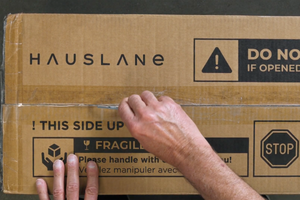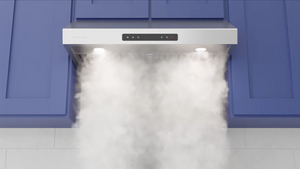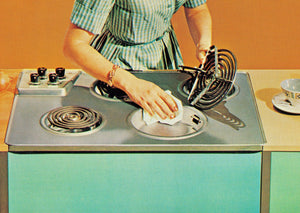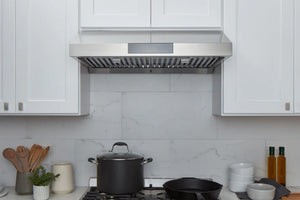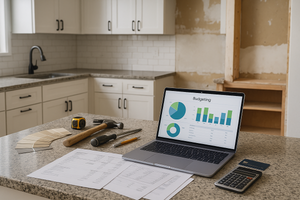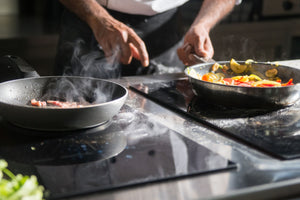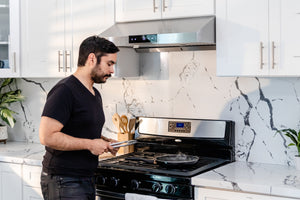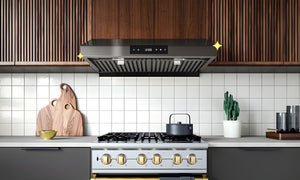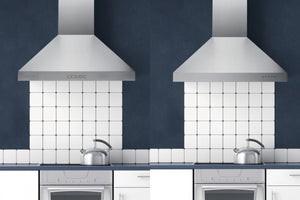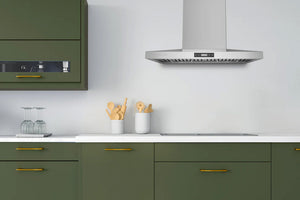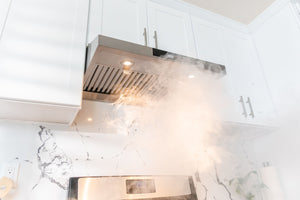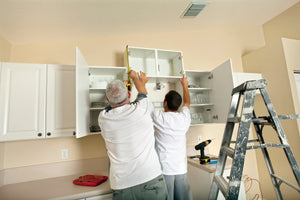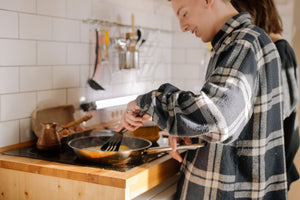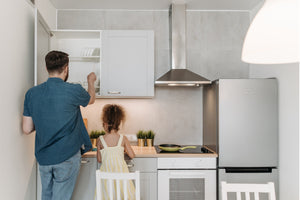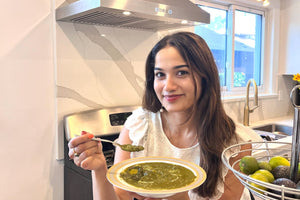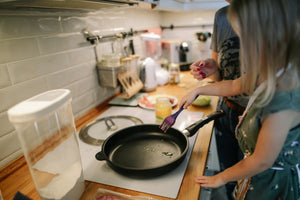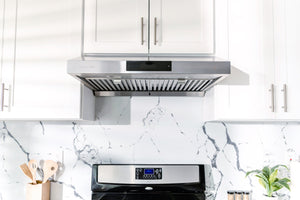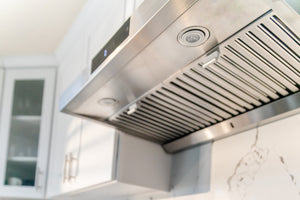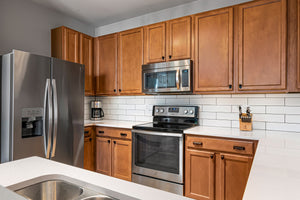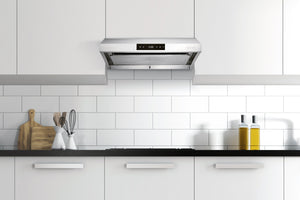TIPS & GUIDES
What Research Says About Cooking Fumes and Their Impact on Your Health
By Hauslane ∙ 15 mins readMany people increased how much they prepare meals at home during the pandemic. Research indicates that 70% of households in the United States prepared 80% of their meals at home in 2020. In 2019, only 30% of American homes used their place of living as the central meal preparation spot. What’s more, 7 out of 10 consumers say they’ll keep cooking at home after the pandemic ends.

We’ve all heard the benefits of cooking at home, from better nutrition to dollars saved. Home-prepared meals are estimated to be about 5 times cheaper than those purchased at restaurants. On the nutrition side of things, people who cook the majority of their meals at home consume fewer carbohydrates, less sugar, and fat than those who cook less or not all.
There’s no doubt that there are many advantages to preparing meals in your home kitchen. However, you may have never considered one nasty side effect: cooking fumes. Every time you prepare a meal using an oven or stove, you produce fumes, chemicals, and smoke.
If your kitchen isn’t properly equipped with the right ventilation tools, those chemicals can have an impact on your health. Let’s first explore what exactly makes up cooking fumes and their known side effects. Then, we’ll look at how to safeguard your health so you can enjoy cooking at home worry-free.
What Are Cooking Fumes?
Researchers define cooking smoke as being comprised of “particulate matter and a large number of toxic gases.” These toxic gases include carbon monoxide, nitrogen dioxide, and several toxic volatile hydrocarbons, some of which are carcinogens. They also contain harmful trace elements, many of which arise from heating cooking oil.
According to Science Direct, the most abundant trace elements are produced when grilling meat with heating cooking oil and salt. Their risk analysis revealed “an unacceptable carcinogenic risk from chronic exposure to some of those elements, such as Cr and Co.” Cooking with gas is also known to produce more toxic fumes and indoor pollution.
Volatile organic compounds (VOCs) are airborne chemicals that are also present in cooking fumes. It’s easy to breathe in VOCs and particulate matter as they’re invisible to the human eye. Regularly breathing in these chemicals is particularly risky for people with breathing problems, asthma, and allergies.
What is the Heath Impact of Cooking Fumes?
The health impact of airborne chemicals and particulate matter varies based on exposure. In the short term, exposure can lead to irritation of the eyes, nose, and throat, as well as headaches, nausea, and asthma attacks. Repeated exposure may lead to cancer as well as damage to the nervous system, liver, and kidneys in the long term.
There is also a potential risk to unborn children. High exposure to VOCs may lead to:
✦ Lower birth weights
✦ Negative impact on physical development
✦ Lower immunity
Cooking smoke is associated with an increased risk of acute respiratory infection in children and several chronic illnesses, such as chronic bronchitis. Exposure to indoor air pollution nearly doubles the risk of childhood pneumonia. It is responsible for 45% of all pneumonia deaths in children under five years old.
For adults, cooking smoke is associated with an increased occurrence of chronic obstructive pulmonary disease in women and lung cancer. It is also linked to respiratory symptoms such as coughing, chest tightness, phlegm, labored breathing, and wheezing.
According to the World Health Organization (WHO), 3.8 million people have died prematurely from indoor air pollution due to the improper use of solid fuels and kerosene for cooking. Of the deaths:
✦ 27% were from pneumoni
✦ 27% from heart disease
✦ 20% from chronic obstructive pulmonary disease (COPD)
✦ 18% from stroke
✦ 8% from lung cancer
There are several factors that play into the emission of pollutants and chemicals. One of the most common factors is temperature, the food prepared, and the use of cooking oil. Stir-fry cooking is associated with a higher emission of particles, especially when combined with grilling beef and corn oil. This finding aligns with research from the Norwegian University of Science and Technology. Researchers found that the risk of heating meat to high temperatures can create compounds associated with causing cancer in animals and possibly humans.
Researchers set out to discover why Taiwanese women experience a higher rate of lung cancer despite the fact only 10% of them smoke. Cooking was associated with higher risks of lung cancer. The risk increased for women who waited until the cooking oil was very hot before cooking their food. Higher lung cancer rates are found amongst Chinese chefs who cook in confined spaces with a wok.
How to Properly Ventilate Your Kitchen
There’s no denying that cooking can negatively impact the indoor air quality of your home. Still, there’s no need to stop cooking at home. Prioritize ventilation to avoid the side effects of indoor air pollution such as respiratory problems, increased risk for cancer, and organ damage.
There are several ways to ventilate your home, such as opening windows and doors. However, the most effective way to do so is with a range hood. An article from the Scientific Reports journal explains, “two recent meta-analyses both demonstrated a significant protective effect of fume extractor use and good ventilation on lung cancer risk.
Range hoods are designed to extract fumes, chemicals, and smoke from the interior of your home. Ducted range hoods suck up and vent out odors and fumes produced when cooking. Ductless models do not vent them out but instead clean and recirculate the air through the use of charcoal filters. Ducted cooking hoods are the most effective choice. However, if you don’t have ductwork, a ductless model will still neutralize your air much better than simply opening a window or turning on a fan.
For best results, turn on the range hood a few minutes before you start cooking. Leave it running for about 15 minutes after you finish cooking. If you have a model with multiple speed settings, select the appropriate speed for your level of cooking. For stir-frying, you’ll want to turn it on to the highest setting available. For ductless models, be sure to change the filters per the manufacturer’s recommendations (usually around every two months for normal use).
You can combine your range hood with a ceiling fan or the fan mode on your HVAC system to maximize ventilation. Air purifiers with carbon filters are another good way to neutralize odors. However, keep in mind fans, and purifiers won’t fully extract fumes. Instead, look at them as a supplement to your range hood.
Today, there are plenty of options for range hoods, which vary based on size, style, type, and more. Whether you’re shopping for your first range hood or replacing an existing model, Hauslane can help. Check out our ultimate buyer’s guide so you can find the ideal range hood for your kitchen.
Sources:
https://www.nature.com/articles/s41598-020-63656-7
https://link.springer.com/chapter/10.1007/978-981-13-6496-9_3
https://www.sciencedirect.com/science/article/pii/S2405844018374413
https://www.mcgill.ca/oss/article/science-science-everywhere/mothballs-and-steaks
https://www.bbc.com/future/article/20200625-the-hidden-risks-of-cooking-your-food
https://www.discovermagazine.com/health/are-cooking-fumes-bad-for-your-health
https://www.bbc.com/future/article/20200625-the-hidden-risks-of-cooking-your-food






